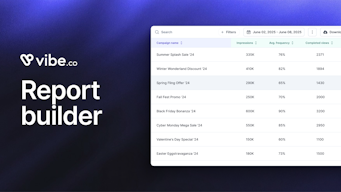Beyond A/B Testing Ads - How to Really Track Campaign Performance
Marketing teams employ a variety of strategies to determine the effectiveness of ad campaigns. For years, A/B testing reigned supreme as the ultimate creative testing method. The way it works is simple: A/B testing shows two versions of a variable. For example, a retail store hosting a holiday sale would employ an A/B test by creating two special offer landing pages and compare results to optimize the impact of their ad. Creative customizations can vary from color schemes to highlighted products to message verbiage. The two variants are then served to users randomly to determine which version results in more conversions. The marketing team uses this statistical analysis to predict consumer preferences and create more profitable ads. But today, thanks to CTV ad platforms, marketers can run many campaign tests at once, and edit their campaigns on the fly. Here's how.
Limitations of A/B Testing
As digital marketing channels continue to advance, the limitations of A/B testing become more apparent. While this method can provide usable data, there are several things that could be improved by using an A/B testing strategy.
Time & Resources
To complete a proper A/B test, marketers need to allow time for both ad versions to be served to their target audience. As a result, it can take a long time to collect and analyze data, and A/B testing is often ineffective for short-term promotions or last-minute sales.
Changes in Behavior
A/B testing compares specific creatives, and the resulting data only applies to that comparison. The test does not account for changes in consumer shopping behaviors or interests. Every time a target audience is redefined, no matter how minutely, another A/B test needs to be performed. Therefore, A/B tests are only truly actionable if they are ongoing.
Track Campaign Performance With CTV
CTV ad reporting platforms go beyond A/B testing to provide marketing teams with more detailed, actionable data that can better refine marketing strategies. Unlike A/B tests, most CTV platforms’ ad customization options allow businesses to compare multiple variables simultaneously and make campaign edits on the fly, which leads to more robust creative content and higher ROI.
Better Performance Metrics With CTV
A business’s return on marketing dollars should be more than just frequency or impression numbers. Views, likes, and comments are low-level conversions that do not always correlate to sales. Instead, businesses need to know how much money their ads generate. CTV is one of the only digital marketing channels that generate performance metrics based on viewer engagement, conversions, and consumer actions after seeing the ad. As a result, businesses can see exactly how much money a CTV ad generated compared to the cost of running the campaign.
Premium Testing Options on CTV
CTV ad platforms like Vibe.co offer a variety of testing options to refine video marketing strategies. Businesses can take advantage of several creative comparisons, including the following:
- Standard A/B testing
- Multiple variable ad testing
- Test audiences, including testing audiences against each other
- Incrementality testing that shows the effect of CTV versus results from other advertising channels
These premium test options are part of any good CTV platform’s offerings and are not an additional expense to marketing teams, so businesses can get and analyze data faster and improve their marketing ROI.


